Research
Publication
-
-Please see the list here on INSPIRE.
-
-Or, alternatively, please see my CV (in PDF format; as of November 2015).
Research summary
I am working on particle astrophysics and cosmology. In particular, I am interested in dark matter problem in the Universe, and how to probe it using annihilation products such as energetic gamma rays and neutrinos. Although I am a theoretical astrophysicist, I always consider prospects of current or near future generation of experiments and telescopes.
I worked with many people of various backgrounds. My main collaborators are found in the following list (alphabetical).
-
•John Beacom (Ohio State U.)
-
•Aurélien Benoit-Lévy (UCL)
-
•Shunsaku Horiuchi (Virginia Tech)
-
•Koji Ishiwata (Kanazawa U.)
-
•Marc Kamionkowski (Johns Hopkins U.)
-
•Eiichiro Komatsu (Max-Planck Institute for Astrophysics)
-
•Alexander Kusenko (UCLA)
-
•Peter Meszaros (Penn State U.)
-
•Kohta Murase (Penn State U.)
-
•Daisuke Nagai (Yale U.)
-
•Ehud Nakar (Tel Aviv U.)
-
•Vasiliki Pavlidou (U. Crete)
-
•Stefano Profumo (UC Santa Cruz)
-
•Re’em Sari (Hebrew U.)
-
•Katsuhiko Sato (IPMU, U. Tokyo)
-
•Tomonori Totani (Kyoto U.)
-
•Christoph Weniger (U. Amsterdam)
Also, see here for my current and past students and postdocs and their publications.
Below, I summarize some of my research highlights.
Particle Dark Matter
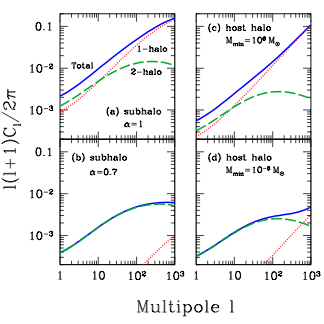
I also analytically worked out the angular power spectrum from the Galactic substructure (Ando 2009). This results not only confirmed the previous studies by others but also enabled physical understanding of the possible signal in terms of substructure models. With Samuel Lee and Marc Kamionkowski, I also worked on one-point statistics of the gamma-ray background, i.e., probability distribution function of the gamma-ray flux, and pointed out that the signature from the Galactic substructure should be discriminated from that from the smooth dark-matter component (Lee et al. 2009). Michael Feyereisen, Lee, and I revisited this problem in the case of extragalactic dark matter halos (Feyereisen et al. 2015).
With Kamionkowski, Lee, and Savvas Koushiappas, I pointed out that the detectability of proper motions of small substructure through gamma rays is very small (Ando et al. 2008a). The discussion is based on the upper limit of the diffuse gamma-ray background measured with EGRET instrument on board the Compton Gamma-Ray Observatory.
I also pointed out that the signals from the Galactic center strongly constrain the dark-matter contribution to the gamma-ray background (Ando 2005).
The series of my papers on gamma-ray background motivated a dedicated data analysis by the Fermi-LAT collaboration in 2012, in which the angular power spectrum was detected for the first time and the level of anisotropy was found to be consistent with my prediction for astrophysical sources that I made in Ando et al. (2007). Komatsu and I interpreted this result to put the latest constraints on the dark matter annihilation cross section (Ando & Komatsu 2013).
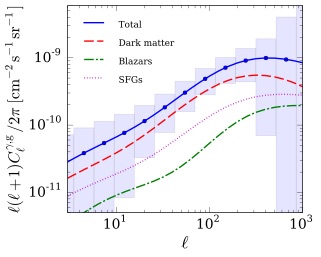
The gamma-ray intensity from dark matter annihilation depends on the amount of substructure in dark matter halos. Richard Bartels and I revisited the modeling of these substructure boost factor, by taking tidal stripping properly into account (Bartels & Ando 2015). We found that the conventional estimate of the boost by using concentration-mass relation for field halos will end up underestimate of the gamma-ray flux by a factor of 2 to 5. With Roberta Diamanti and Maria Cabrera, I estimated the dependence of the subhalo boost on minimum mass of the smallest dark matter structure (Diamanti et al. 2015).
High-Energy Astrophysics
High-energy astrophysical sources such as active galactic nuclei (AGNs) and gamma-ray bursts (GRBs) are also fascinating sources by themselves. Their radiation mechanisms and particle acceleration mechanisms are not totally understood. I worked on several aspects on high-energy astrophysics, especially focusing on high-energy gamma rays and neutrinos.
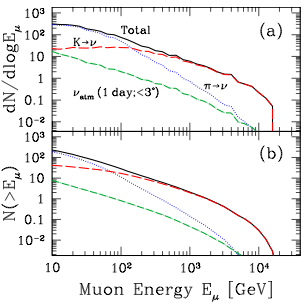
With Ehud Nakar and Re’em Sari, I predicted number of expected detection of GRBs with Large Area Telescope on Fermi (Ando et al. 2008b). Our prediction was based on the fluence upper limits and detections due to EGRET, which was, albeit their importance, totally neglected in the previous studies. From this approach, we predicted the detection rate of about 10–15 per year, which turned out to be more or less the right number. During this study, we also pointed out that the effect of Compton scattering in the Klein-Nishina regime could significantly change spectra of the GRB prompt emission (Nakar et al. 2009).

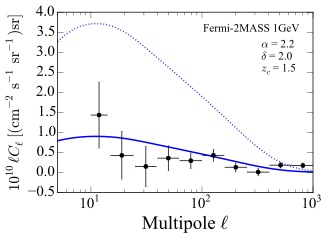
Supernova Neutrinos
Neutrino is the only particle that shows features beyond the standard model such as nonzero masses and mixings. I started my research career by studying supernova neutrinos from various aspects. For example, with Katsuhiko Sato, I pointed out that the neutrinos detected with Super-Kamiokande would tell us the direction of supernova with the precision of 5–10 degrees (Ando & Sato 2001), and also theoretically calculated the flavor conversion involving nonzero magnetic moment showing that the feature is very characteristic in both energy and time information (Ando & Sato 2003a, b, c).
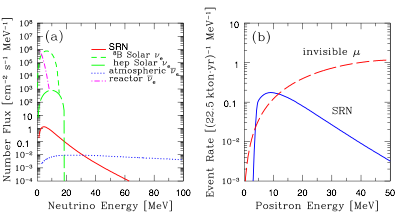
With John Beacom and Hasan Yuksel, I considered detection prospects of supernova neutrinos from nearby galaxies (Ando et al. 2005). Using the updated galaxy catalog and supernova catalog, we showed that the rate of detection with future Mton-scale detectors is more than 1 per year, and can be significantly improved with a 5-Mton detector (Kistler et al. 2008).
Cosmology
Many of my papers are related to some cosmological problems in the Universe. For example, the dark matter mentioned above is of course one such example. There are also number of cosmological issues including mystery of dark energy, how to probe primordial power from microwave background or large-scale structure etc.
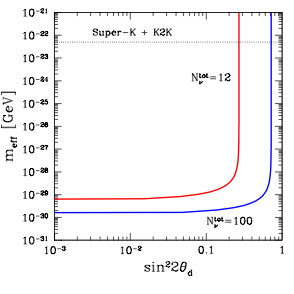

With Kamionkowski, I also studied primordial (statistical) anisotropy of the density fluctuations plausibly induced by some inflation mechanisms (Ando & Kamionkowski 2008). We worked out the nonlinear evolution of such density fluctuations, and showed that the nonlinear effect does suppress the primordial anisotropy, but by no larger than several percent. Thus the detection would likely imply existence of primordial anisotropic power.
